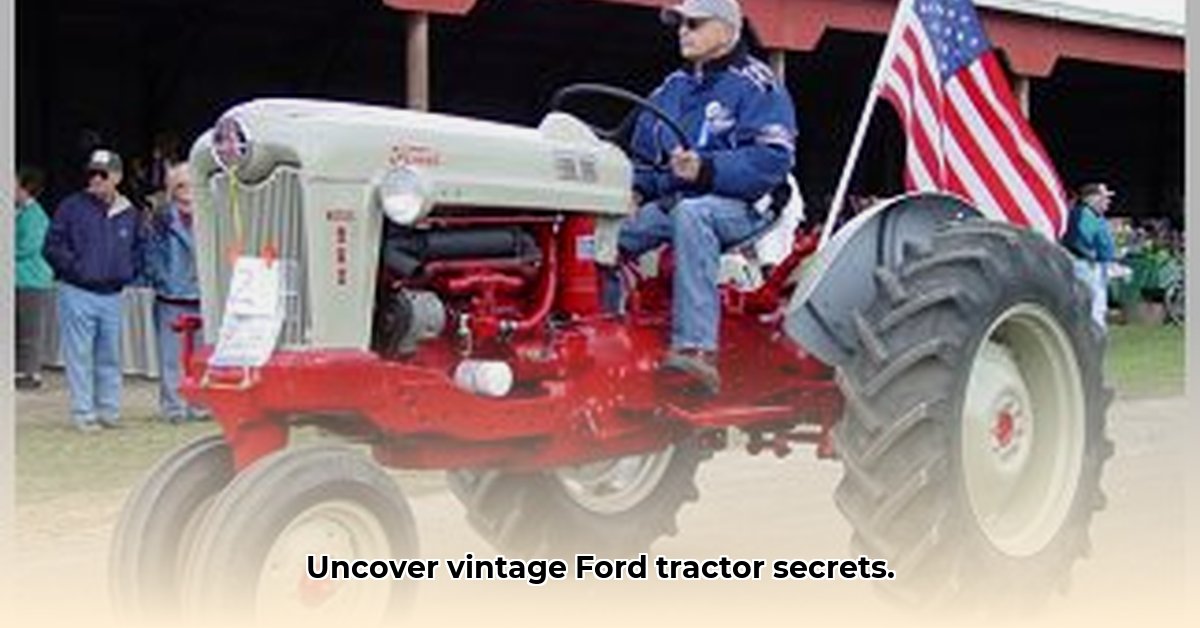
The rumble of a vintage Ford tractor—that unmistakable sound—evokes images of hardworking farmers, sun-drenched fields, and a bygone era of agricultural ingenuity. But these aren't just rusty relics; they represent a pivotal chapter in farming history, a story of innovation and evolution that continues to resonate today. For more information on a specific model, check out this 1948 Ford Tractor resource. Let's explore the fascinating world of old Ford tractor models, examining their design, their impact, and their enduring legacy.
The 9N: A Revolution in the Fields
Imagine the late 1930s. Farming was largely horse-powered. Then, Ford introduced the 9N, a tractor that wasn't just an improvement—it was a revolution. The game-changer? The Ferguson three-point hitch (a system for easily attaching and detaching farm implements). This simple yet brilliant innovation, similar to swapping tools on a power drill, drastically boosted efficiency and remains a cornerstone of modern tractor design. The 9N's sturdy build and distinctive style quickly made it a farmer favorite, a symbol of progress across the nation. Did you know that the initial success of the 9N spurred a wave of similar designs, fundamentally altering agricultural practices worldwide?
From 9N to 8N: Building on Success
The 9N's success wasn't accidental. Ford engineers continuously refined the design. The 2N followed with minor upgrades, but the 8N ("Jubilee") was a true breakthrough. It wasn't just about added horsepower; it demonstrated Ford's commitment to understanding and meeting evolving customer needs. The 8N boasted increased power, enhanced durability, and a host of improvements reflecting a deeper understanding of farm work realities. It became a workhorse for generations, its image indelibly etched in agricultural history. Think about the sheer longevity of the 8N; its widespread adoption speaks volumes about its reliability and effectiveness.
Material Matters: Aluminum vs. Steel – A Tale of Two Metals
Early Ford tractors, especially the 9N, used aluminum for parts like the hood, due to its lighter weight and improved maneuverability. However, aluminum was also more expensive and easily dented. Later models, such as the 8N, increasingly favored steel—tougher, more durable, but heavier. This material shift reflects the economic pressures and demand for robust equipment to withstand daily farm work. It's a story of balancing cost-effectiveness with functionality. How did this material choice affect the overall performance and longevity of these tractors?
Beyond the Engine: Design Details and Innovation
The evolution extended beyond engine refinements. The transition from the highly sought-after “smooth axle” in early models to later designs illustrates the ongoing balance between functionality, performance, and manufacturing costs. Even the seemingly mundane casting codes used to date parts highlight Ford's meticulous attention to detail and quality control – a testament to their engineering legacy. What other design features contributed to the enduring appeal of these iconic tractors?
More Than Machines: The Collector's World
The enduring appeal of old Ford tractors is undeniable. These aren't just tools; they're tangible pieces of history. Collectors are drawn to their craftsmanship, history, and the stories they represent. The scarcity of certain parts, such as those original aluminum hoods, enhances their value and allure. Today, dedicated enthusiasts meticulously restore and maintain these machines, cherishing their heritage and celebrating Ford's lasting impact on agriculture. These are not just valuable machines; they embody a special era and a connection to the past. What drives the passion of these dedicated Ford tractor collectors?
The Enduring Legacy: Consolidation and Continued Influence
Ford's tractor division, once a dominant force, eventually merged with New Holland. This wasn't a failure but reflected industry consolidation trends. Despite the merger, Ford's impact on tractor design remains profound. The legacy of these old Ford tractors continues to inspire, subtly influencing designs and innovations today. What started with the humble 9N revolutionized farming, leaving an indelible mark on agricultural history. How did the integration with New Holland ultimately shape the future of agricultural machinery?
Notable Ford Tractor Models
| Model | Years Produced | Key Features | Significance |
|---|---|---|---|
| Ford 9N | 1939-1947 | Ferguson three-point hitch, innovative design | Revolutionized tractor design and farming efficiency |
| Ford 2N | 1942-1948 | Minor improvements on the 9N | Bridged the gap between 9N and 8N |
| Ford 8N | 1947-1952 | Increased horsepower, improved durability | Became a ubiquitous workhorse on farms worldwide |
| Ford NAA | 1952-1953 | Increased horsepower, more comfortable operator position | Introduced design refinements over the 8N |
| Ford 600 | 1953-1959 | Hydraulic power steering, increased power | Modernized features for improved operational ease |
This is just a snapshot; many variations and related models exist, demonstrating the continuous evolution and response to changing farmer needs. Research into specific models and subtle differences continues, enriching our understanding of this historic agricultural technology.
Identifying Your Ford Tractor: A Multifaceted Approach
Identifying a specific Ford tractor model requires a multi-pronged approach: examining serial numbers, casting codes, and visual features. Serial numbers, typically found on the left engine block, provide a starting point, but aren't always perfectly accurate. Casting codes – numbers stamped on engine blocks and other components – offer clues about manufacturing dates, though discrepancies can occur. Visual cues, such as hood material, fender design, and other component variations, help refine the estimation of the tractor's production year.
This detailed examination allows enthusiasts to pinpoint their tractor's approximate production year and even identify rare models or specialized variations, turning the process of identification into a rewarding endeavor.